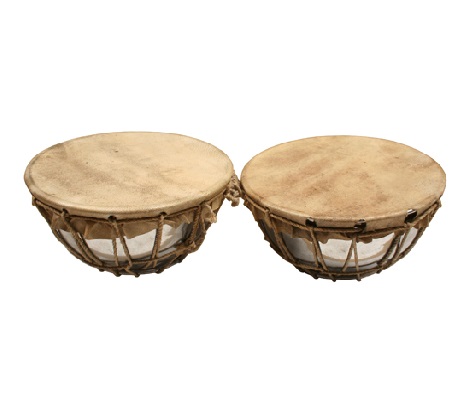Naqareh
Percussions
Asia
Ancient
Video
The Naqareh, also known as Naqqāra, Nagara, or Nagada, is a traditional Middle Eastern percussion instrument characterized by its double-drum structure. Typically played in pairs, the Naqareh consists of two drums of differing sizes, with one producing higher pitches and the other generating lower tones. The instrument’s rounded back is often made of baked clay, while the drumheads are crafted from animal skins, such as cows or sheep, which are tightly secured to the frame. This construction allows the Naqareh to produce a rich and resonant sound that is integral to various musical traditions across the Middle East particularly in Iran.
Type of Instrument
The Naqareh falls under the category of membranophones, specifically a type of kettle drum. This classification is defined by its reliance on a membrane (the drumhead) that vibrates to produce sound when struck. The instrument is typically played using wooden sticks known as damka, which are designed to enhance the tonal quality of the strikes. The Naqareh’s unique sound is further distinguished by its dual-drum setup, allowing for a dynamic range of pitches and rhythms.
History
The history of the Naqareh can be traced back to ancient times, with its roots firmly planted in Asia and specifically within the cultural contexts of Iran. Historical accounts suggest that this instrument has been in use since at least the 14th century, although its origins may extend further back. The term “Naqqāra” derives from the Arabic verb “naqr,” meaning “to strike” or “to beat,” reflecting its function as a percussion instrument. The Naqareh gained prominence during the Qajar era (19th century AD), where it became widely utilized in various ceremonial and folk music contexts throughout Iran. Its influence spread beyond the Middle East, particularly during the Crusades, when it was adopted into European musical traditions under names like naccaire or naker. This cross-cultural exchange highlights the Naqareh’s significance not only as a regional instrument but also as a component of global musical heritage.
Construction
The construction of the Naqareh involves careful craftsmanship that combines traditional techniques with local materials. The main body of the drum is typically made from either copper or clay, which contributes to its distinctive sound quality. The drumheads are crafted from animal skins, chosen for their ability to resonate when struck.
Features
Size: The Naqareh consists of two drums—one larger and one smaller—allowing for a range of pitch variations.
Material: The body can be made from copper or clay, while the heads are usually made from cow or sheep skin.
Playing Position: It can be played while mounted on a stand or tied to an animal, such as a horse or camel, for mobility during performances.
Accompaniment: In celebratory contexts, it is often accompanied by wind instruments like the Sorna or trumpet.
Types
There are several types of Naqareh used in different contexts:
- Sarjashni: A smaller Naqareh that resembles a bowl and is played continuously throughout performances.
- Gurgeh: A larger drum with a high-pitched sound, shaped like an egg cut in half.
- Egg-shaped Naqareh: Similar to Gurgeh but smaller in size.
- Ordinary Drum: A more generalized version used in various musical settings.
Each type serves specific roles within musical compositions and ceremonies, showcasing the versatility of this instrument.
Sound Production
Sound production in the Naqareh occurs by striking the drumheads with sticks. The interaction between the stick and membrane generates vibrations that create sound waves. The larger drum typically produces higher-pitched sounds, while the smaller drum offers deeper tones. The combination allows for complex rhythmic patterns and harmonies that enrich musical performances.
Playing Methods
Playing methods for the Naqareh vary depending on cultural context and performance setting:
- Sticks: Musicians use specially designed wooden sticks to strike the drumheads, creating distinct sounds based on force and angle.
- Technique: Players often employ varied techniques such as rolls, accents, and dynamic shifts to enhance expressiveness.
- Accompaniment: In many settings, Naqareh players collaborate with other musicians, creating layered textures through rhythmic interplay.
Roles in Music
The Naqareh plays a vital role in both ceremonial and folk music across Iran and surrounding regions:
Ceremonial Use: It is prominently featured in religious ceremonies, particularly within shrines such as that of Imam Reza in Mashhad, where it accompanies prayers and rituals.
Folk Music: In regional folk traditions like Gilaki and Kurdish music, it serves as a key rhythmic element that drives dance and communal celebrations.
Cultural Symbolism: Beyond its musical functions, the Naqareh symbolizes cultural identity and continuity among communities that cherish their musical heritage.
The Naqareh is not just an instrument but a significant cultural artifact that embodies centuries of musical tradition and social practice. Its unique construction, diverse types, and integral role in various musical contexts highlight its importance within both local and broader musical landscapes.
FAQ
What kind of music is typically played with the Naqareh?
The Naqareh is traditionally used in ceremonial, military, and classical music. Its deep, resonant beats often set the rhythm for processions or religious rituals. The instrument has been a central part of court music in many cultures. It is also used in folk music to accompany dances and storytelling.
What are the different types of Naqareh?
The Naqareh comes in various types, differing in size, shape, and material. Some are small hand-held drums, while others are large floor-standing instruments. Common types include paired kettledrums used in orchestras or religious settings. Regional variations may include unique decorations and tuning techniques.
What materials are used to make Naqareh instruments?
Naqareh drums are typically made from metal, wood, or clay for the body. The drumheads are traditionally crafted from animal skin, like goat or camel hide, stretched tightly over the frame. Rope or leather straps are used for tuning. The combination of materials produces its distinctive, resonant sound.
 Links
Links
References
Other Instrument
Categories


















